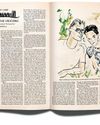Try GOLD - Free
HARLEM IS EVERYWHERE
The New Yorker
|March 11, 2024
Denise Murrell takes on the Harlem Renaissance at the Met.

I first learned about Denise Murrell— the curator and scholar behind the Metropolitan Museum of Art’s big and shiny new spectacle, “The Harlem Renaissance and Transatlantic Modernism” (through July 28th)—in 2018, when I saw her landmark exhibition, “Posing Modernity: The Black Model from Manet and Matisse to Today,” at Columbia University’s Wallach Art Gallery, in Harlem. The show, which occupied a relatively small space but never felt cramped, apprised us of what had been left out of the available history (even the British art historian T. J. Clark’s essential 1984 study, “The Painting of Modern Life”): the importance and the resonance of the Black female presence in the early days of modernism. As someone who’d been enamored of nineteenth-century French literature in college, I’d longed to know more about the poet Charles Baudelaire’s mixed-race lover, Jeanne Duval, the inspiration for his “Vénus noire,” in “Les Fleurs du Mal” (1857). From “Posing Modernity,” I learned not only that Duval had been an actress when she met Baudelaire, in the early eighteen-forties, but that, during her volatile relationship with the poet, she visited artists and writers with him and frequented a coffeehouse on the Rue de Richelieu. I knew, from Clark and other scholars, that Baudelaire’s depiction of the changes in industrial-era Paris had influenced his friend Édouard Manet, but it was Murrell who showed me that one reason works such as Manet’s 1862 painting “Baudelaire’s Mistress (Portrait of Jeanne Duval)”—in which we see difference that is not sentimental or exoticized, that looks back at us with no need to be liked or adored—were powerful was that they also at times illuminated how difference looked at itself.
This story is from the March 11, 2024 edition of The New Yorker.
Subscribe to Magzter GOLD to access thousands of curated premium stories, and 10,000+ magazines and newspapers.
Already a subscriber? Sign In
MORE STORIES FROM The New Yorker

The New Yorker
THE TALK OF THE TOWN
The militarization of American cities, including Los Angeles, Portland, and Chicago, has brought home a perverse irony. T
4 mins
October 20, 2025

The New Yorker
THIS IS MISS LANG
The brief life and forgotten legacy of a remarkable American poet.
19 mins
October 20, 2025

The New Yorker
RAMBLING MAN
Peter Matthiessen's quest to escape himself—at any cost.
15 mins
October 20, 2025

The New Yorker
DEGREES OF HOSTILITY
How far will the Administration's assault on colleges and universities go?
26 mins
October 20, 2025

The New Yorker
GOINGS ON
What we're watching, listening to, and doing this week.
6 mins
October 20, 2025

The New Yorker
READY OR NOT
Zohran Mamdani wants to transform New York City. Will the city let him?
37 mins
October 20, 2025

The New Yorker
Alexandra Schwartz on Joan Acocella's "The Frog and the Crocodile"
When I am stuck on a sentence or trying to wrestle an idea into shape, I turn to Joan Acocella.
3 mins
October 20, 2025

The New Yorker
A BROTHER'S CONVICTION
Did a grieving man's quest for justice go too far?
43 mins
October 20, 2025

The New Yorker
THE KEY TO ALL MYTHOLOGIES
Why the quest for a master code goes on.
13 mins
October 20, 2025

The New Yorker
FOR ART'S SAKE
\"Blue Moon\" and \"Nouvelle Vague.\"
6 mins
October 20, 2025
Listen
Translate
Change font size
